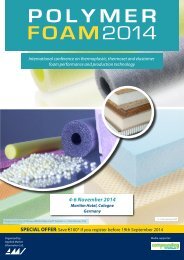Dissertations in Forestry and Natural Sciences
24lYKFN
24lYKFN
You also want an ePaper? Increase the reach of your titles
YUMPU automatically turns print PDFs into web optimized ePapers that Google loves.
Wood-plastic composites<br />
However, WPCs have usually been processed at high<br />
temperatures, which may change the VOC emission<br />
characteristics of the material. Furthermore, the <strong>in</strong>corporation<br />
of additives exert effects on the VOCs.<br />
Schwarz<strong>in</strong>ger et al. (2008) conducted an elemental analysis<br />
of different WPCs by two-stage pyrolysis-GC/MS (gas<br />
chromatography-mass spectrometry). In addition to the<br />
identification of marker compounds for different wood types,<br />
they identified pyrolysis products from polymers (PE, PP, <strong>and</strong><br />
PVC), which is important with respect to VOCs. Furthermore,<br />
their analysis of WPCs with various lignocelluloses provided<br />
further <strong>in</strong>sights <strong>in</strong>to the fundamental differences between<br />
WPCs with different re<strong>in</strong>forcements.<br />
Félix et al. (2013) exam<strong>in</strong>ed the release of VOCs from WPCs<br />
made from l<strong>and</strong>fill-derived plastic <strong>and</strong> sawdust. Their f<strong>in</strong>d<strong>in</strong>gs<br />
were <strong>in</strong> accordance with those of Schwarz<strong>in</strong>ger et al. (2008); the<br />
key markers for WPCs were phenols <strong>and</strong> aldehydes. In general,<br />
the profile of VOCs displayed alkanes, alkenes, phenols,<br />
aldehydes, aromatic hydrocarbons, terpenes, carboxylic acids,<br />
esters, nitrogen compounds, ketones, <strong>and</strong> alcohols. The most<br />
abundant VOCs <strong>in</strong> WPCs were furfural, -p<strong>in</strong>ene, 2-ethyl-1-<br />
hexanol, 2-methoxyphenol, N-methylphthalimide, butylated<br />
hydroxytoluene, 2,4-di-tert-butylphenol, <strong>and</strong> diethylphthalate.<br />
In addition, Félix et al. (2013) demonstrated that the<br />
<strong>in</strong>corporation of additives <strong>in</strong>creased the release of certa<strong>in</strong> VOCs.<br />
Another important f<strong>in</strong>d<strong>in</strong>g was that WPCs have the potential to<br />
emit off-odor compounds that cannot be completely masked by<br />
odoriz<strong>in</strong>g agents. The identified off-odor compounds <strong>in</strong> WPCs<br />
<strong>in</strong>cluded acetylfuran, hexanal, 4-v<strong>in</strong>ylguaiacol, acetic acid, <strong>and</strong><br />
2-methoxyphenol.<br />
One way to control VOC emissions from WPCs is to<br />
<strong>in</strong>corporate odorants <strong>in</strong>to the composites to mask at least part<br />
of the off-odor compounds (Félix et al. 2013). Moreover, the<br />
addition of other types of additives capable of affect<strong>in</strong>g the odor<br />
characteristics along with the other properties of WPCs could<br />
provide a simple solution. Another approach, proposed by Yeh<br />
et al. (2009), is to cover the composite with a th<strong>in</strong> layer of virg<strong>in</strong><br />
<strong>Dissertations</strong> <strong>in</strong> <strong>Forestry</strong> <strong>and</strong> <strong>Natural</strong> <strong>Sciences</strong> No 222 41



